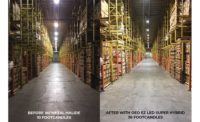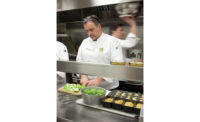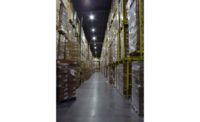From high-power LED luminaires to retrofitting existing features, today’s lighting manufacturers deliver the ultimate in sustainable solutions for the cold food industry. Find out what’s trending in the commercial lighting industry.
Powerful, yet compact LED options
“The most significant change operators can make is to upgrade their existing lighting to energy-efficient LED sources,” says Jason Baright, president of G&G LED, Albany, N.Y. “Modern LED fixtures and smart lighting design can drastically improve lighting quality, increase safety and improve working conditions, all while drastically reducing energy and cooling costs.”
That’s why G&G LED released the patent-pending WPX Series, a new slim-line linear LED fixture designed specifically for coolers, kitchens and onboard food processing equipment as well as cold storage facilities and warehouses.
Additional features include patent-pending push-and-click connectors and cabling system, seamless shell for IP68 ingress protection and UV/chemical resistance, patent-pending embedded aluminum heat sink for operation in cold and hot environments, NSF certification and a full line of colors and beam-forming options.
“Our dimming occupancy sensors may be configured to turn lights off or go to pre-set dimmed settings to provide optimal safety and security while still providing energy savings to the user,” says Baright. “Motion sensing allows for pre-set dimming control to reduce energy consumption and costs without sacrificing lighting quality and safety.”
High bays are the right way
In October 2015, Orion Energy Systems, Inc., Manitowoc, Wis., launched a new generation of Orion LED high bays, designed to achieve unprecedented lumens per watt and are said to save more energy than any other fixture currently available, according to Omar Rivera, senior vice president of product and business development.
The patent-pending ISON high bay | HBIF2, for example, offers up to 179 lumens per watt with best-in-class performance. These lighting solutions are upgradeable and interchangeable, and allow maintenance crews to meet changing light distribution requirements, such as moving from an open area to aisle lighting, or from high bay to even office. The integrated sensors measure room temperature and report to a centralized remote location, and offer ambient operating range of -22°F to 131°F with a rated life of 150,000 hours.
The APOLLO high bay | HBAC2 offers high performance in cost-conscious applications, delivering up to 152 lumens per watt, with an ambient operating range of -22°F to 131°F and rated life of 125,000 hours.
The HARRIS high bay | HBHC1 delivers up to 148 lumens per watt, with ambient operating range of -4°F to 122°F and a rated life of 100,000 hours.
The ISON high bay cold environment | LEDE is designed for cold environments, featuring superior thermal management leading to longer life and enhanced performance. The durable, sleek, aluminum body is available with aisle illumination performance packages for open and aisle applications. Ambient operating range is -40°F to 100°F with a rated life of 150,000 hours.
“This generation of high bays saves 76% more energy, using as little as 107 watts to replace 400-watt metal halide fixtures. For the typical facility with 500 fixtures operating 6,000 hours and a utility rate of $.011, the ISON high bay can save $115,500 in one year, or $1.2 million in the next decade,” says Rivera. “Because LED component technology is continuously improving at a rapid pace, Orion designed its latest high-bay suite with a future-proof, modular platform design that allows facilities to upgrade as the LED performance increases.”
Lighting management software
Another trend impacting today’s lighting industry is the introduction of lighting management software platforms, such as LightRules, produced by Digital Lumens, Boston.
LightRules boasts a new mobile application—LightRules Mobile—which allows quick and easy access to lighting settings from permissioned mobile devices in the facility. This means that facility managers and staff can specify and implement lighting settings with a smartphone or tablet.
“Settings control what happens when occupancy sensors are triggered (e.g., lights on at 100% output for 30% while activity present and off to 10% when area is vacant), what happens when ambient daylight is present (e.g., if there is ambient light available from skylights or open bay doors, fixtures should dim while ensuring target light levels are met),” says Allison Parker, director of marketing. “In addition, entire rooms or zones can be triggered to come on, in sequence or groups, with gradual increase or decrease of light output (dim ramping). The collective benefits of advanced lighting controls integrated into every fixture and managed via software include dramatic energy efficiency (90% lighting energy savings, which is far greater than simple LED fixtures offer) and the flexibility to manage lighting behavior to align with the business needs. In addition, the data from LightRules shows lighting efficiency savings and also provides insight into operational patterns.”
For example, SnoTemp Cold Storage, a Eugene, Ore.-based, family-owned warehousing and distribution company with more than 15 million cubic feet of climate-controlled space, installed Digital Lumens’ lighting management software to reduce its fixture count from 232 HPS 150-watt and 250-watt fixtures to 114 intelligent LEDs.
“Intelligent lighting is really the most practical implementation of the Internet of Things at work, deploying a rich network of sensors across the built environment,” Parker says. “The opportunity for the lighting customer is to consider how to best take advantage of the many capabilities for businesses.”
Meanwhile, Cree, Durham, N.C., released Cree SmartCast Technology lighting controls, an intuitive, self-programming wireless lighting control system that is said to reduce energy consumption by more than 70% when used with Cree LED luminaires. Cree SmartCast Technology delivers intelligent LED lighting without the complex design, installation and setup of typical lighting control systems. This technology features OneButton setup for easy installation, integrated lighting controls for motion sensing and daylight harvesting and wireless communication.
“Warehouses and industrial facilities have expansive lighting needs, spanning more than 17,000 square feet on average and often featuring loading docks designed to handle delivery trucks 24/7,” says Amit Bhojraj, segment marketing manager. “Cree designs high-quality and cost-effective LED solutions that make it compelling to convert every warehouse space to LED.”
Retrofit solutions for existing features
To keep up with the growing demand for LED lighting solutions, Kenall Manufacturing, Kenosha, Wis., introduced a T8 LED retrofit kit for food processing facilities, warehouse distributors and cold storage providers.
The kit—a retrofit solution for existing T8 linear fluorescent fixtures—is said to be the only T8 LED specifically designed to maintain critical listings of installed ingress protected and wet location enclosures typically found in food processing applications, according to Bill Blackley, director, product marketing.
In addition, Kenall launched high-powered versions of its EnviroPro low bay (EPLB) and TekDek (TD17) LED luminaires. The TekDek LED luminaires feature a tertiary lens designed to control glare and come in three models with a range of mounting and distribution options. TekDek is ideal for use in challenging applications, including freezer and cold storage areas, parking structures, retail settings and more.
Kenall also introduced TekLink wired and wireless lighting controls, which offer options for freezer and cold storage areas, warehouses, manufacturing facilities, parking structures and other applications.
“One of the key challenges in the lighting industry is keeping pace with technological changes that are impacting the industry,” says Blackley. “Within the lighting industry, adaptive controls continue to advance, and 2016 will be no exception. As networking platforms and sensor technologies evolve and expand, the electronic-based nature of LEDs presents an ideal opportunity for future innovation.”















